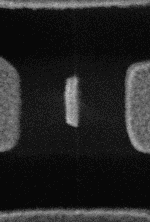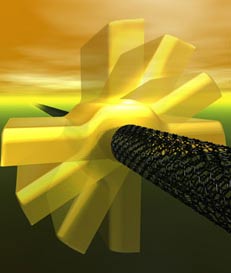APPLICATIONS:
- A variety of MEMS actuator applications
- Microfluidics, catalysis, microarrays
- Chemical and biological sensing
- Mirror movement for optical applications
- Oscillator in wireless and microwave communications
ADVANTAGES:
- Smallest synthetic motor ~ 300 nm wide
- Operates with virtually no friction
- Rotates at up to one billion cycles per second (1 Ghz)
- Extremely durable and long lasting
- Tolerates extreme environmental conditions
- Has low energy requirements (<5 V)
ABSTRACT:
Alex Zettl and colleagues have designed and operated the world’s first rotational nanomotor. The motor is approximately 300 nm wide – three orders of magnitude smaller than existing MEMS motors, and the smallest synthetic motor ever created.
The nanomotor consists of a nanoscale electromechanical actuator that incorporates a rotatable metal plate, with a multi-walled carbon nanotube serving as the motor shaft. The nanotube is composed of single graphite sheets, made up of perfectly arranged carbon atoms, which are rolled up into a tube. Because of the atomic perfection of the carbon bonds, the tube has exceptionally low friction – dissipating very little heat and showing no sign of wear or fatigue.
Low-level, externally applied voltages precisely control the operating speed and position of the rotor plate. With small voltages (<5 V) applied to the stators, the motor has been operated for tens of thousands of cycles, with no apparent wear or degradation in performance or materials. It rotates at up to one billion cycles per second (1 Ghz). Unlike existing MEMS motors or bioactuators and biomotors, the nanomotor operates over a wide range of frequencies, temperatures (cryogenic temperatures to 600° C), and environmental conditions, including high vacuum and harsh chemical environments. (Ref. no. IB-1939)

 A series of scanning electron microscope pictures of the spinning rotor of a nanomotor fabricated in Zettl’s lab. The entire electric motor is about 500 nanometers across, 300 times smaller than the diameter of a human hair. (Credit: Zettl lab) Simulation of nanomotor spinning on multi-walled carbon nanotube. (Credit: Zettl lab)
A series of scanning electron microscope pictures of the spinning rotor of a nanomotor fabricated in Zettl’s lab. The entire electric motor is about 500 nanometers across, 300 times smaller than the diameter of a human hair. (Credit: Zettl lab) Simulation of nanomotor spinning on multi-walled carbon nanotube. (Credit: Zettl lab)
STATUS:
- Published Patent Application. Available for licensing or collaborative research
FOR MORE INFORMATION SEE:
http://www.lbl.gov/msd/PIs/Zettl/03/07_nanomotor/03_7_nanomotor.html
http://www.lbl.gov/Publications/Currents/Archive/Jul-25-2003.html#Zettl
http://www.berkeley.edu/news/media/releases/2003/07/23_motor.shtml
REFERENCE NUMBER: IB-1939